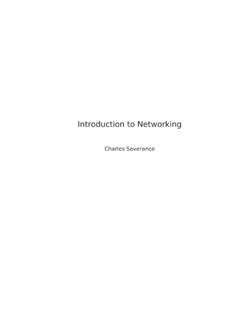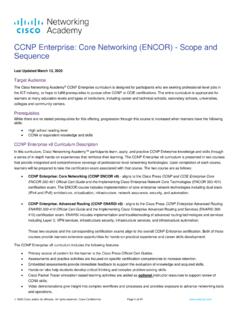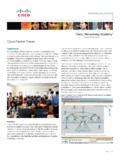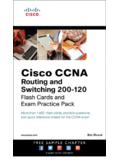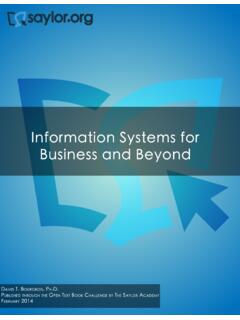Transcription of Introduction to Networking
1 Introduction to NetworkingCharles SeveranceCreditsIllustrations: Mauro ToselliEditorial Support: Sue BlumenbergCover Design: Aimee AndrionThe SketchNote illustrations were drawn on an iPad usingPaperby using a dedicated stylus pencil. The illus-trations were converted from PNG to SVG and EPS vector formatsusing The technical figures for the bookwere drawn with History2015-May-25 Original Printing - CreateSpaceCopyright DetailsThis book is Copyright Charles R. paper/print version of this book is licensed under a CreativeCommons Attribution-NonCommercial International is specifically granted to make copies as necessaryof all or part of the materials in this book as part of a course orcourse copies of this book in EPUB, PDF, and HTML are licensedunder a Creative Commons Attribution International you are interested in translating this book into a language otherthan English, please contact me.
2 I am willing to give commercialprint distribution rights for a complete and responsible goal of this book is to provide a basic understanding of thetechnical design and architecture of the Internet. The bookisaimed at all audiences even those with absolutely no prior tech-nical experience or math skills. The Internet is an amazingly beau-tiful design and should be understood by all who use this book is not about the Network+ or CCNA certifications,I hope it serves as a way to give students interested in thesecertifications a good starting want to thank Pamela Fox of Khan academy for coming up withthe idea of an introductory network technology course initially developed this material as a single week s lecture in theSI502 - Networked Computingcourse that I taught at the Univer-sity of Michigan School of Information starting in 2008.
3 I refinedand expanded the material to be three weeks of the Internet His-tory, Technology, and Security (IHTS) course that I have taught toover 100,000 students on Coursera starting in 2012. This bookadds further detail to create a standalone text that can be readfor enjoyment or used to support an introductory course thatfo-cuses on the Internet s book has been particularly fun in that it is a collaboration withmy friends Mauro Toselli (@xlontrax) and Sue Blumenberg. I metMauro and Sue in 2012 when they became volunteer CommunityTeaching Assistants (CTAs) for my IHTS course on Coursera.
4 Overthe past three years we have become friends and colleagues. Itis a great example of how open education can bring people is supporting material for this book you like the book, let us know. Send us a tweet with yourthoughts. You can also send a tweet if you find an error in R. Severance Arbor, MI USAMay 20, 2015ivContents1 Communicating at a Distance .. Computers Communicate Differently .. Early Wide Area Store-and-Forward Networks .. Packets and Routers .. Addressing and Packets .. Putting It All Together .. Glossary.
5 Questions ..102 Network The Link Layer .. The Internetwork Layer (IP) .. The Transport Layer (TCP) .. The Application Layer .. Stacking the Layers .. Glossary .. Questions ..223 Link Sharing the Air .. Courtesy and Coordination .. Coordination in Other Link Layers .. Summary .. Glossary .. Questions ..314 Internetworking Layer (IP) Internet Protocol (IP) Addresses .. How Routers Determine the Routes .. When Things Get Worse and Better .. Determining Your Route .. Getting an IP Address .. A Different Kind of Address Reuse.
6 Global IP Address Allocation .. Summary .. Glossary ..505 The Domain Name Allocating Domain Names .. Reading Domain Names .. Summary .. Glossary .. Questions ..606 Transport Packet Headers .. Packet Reassembly and Retransmission .. The Transport Layer In Operation .. Application Clients and Servers .. Server Applications and Ports .. Summary .. Glossary .. Questions ..70 CONTENTSvii7 Application Client and Server Applications .. Application Layer Protocols .. Exploring the HTTP Protocol .. The IMAP Protocol for Retrieving Mail.
7 Flow Control .. Writing Networked Applications .. Summary .. Glossary .. Questions ..858 Secure Transport Encrypting and Decrypting Data .. Two Kinds of Secrets .. Secure Sockets Layer (SSL) .. Encrypting Web Browser Traffic .. Certificates and Certificate Authorities .. Summary .. Glossary .. Questions ..979 The OSI Physical (Layer 1) .. Data Link (Layer 2) .. Network (Layer 3) .. Transport (Layer 4) .. Session (Layer 5) .. Presentation (Layer 6) .. Application (Layer 7) .. Comparing the OSI and TCP/IP Models .. Link Layer (TCP/IP).
8 Layer (TCP/IP) .. Layer (TCP/IP) .. Layer (TCP/IP) ..10610 Wrap Up109 Chapter 1 IntroductionUsing the Internet seems pretty easy. We go to a web addressand up comes a page. Or we go to our favorite social site andsee pictures of our friends, families, and pets. But it takesa lotof complex software and hardware to make the Internet seem sosimple. The design of the technologies that make today s Inter-net work started in the 1960s, and there were over 20 years ofresearch into how to build internetworking technologies beforethe first Internet was built in the late 1980s by academics in aproject called NSFNet.
9 Since then, the research and developmentinto improving network technologies has continued as networkshave become far larger and faster and globally distributed withbillions of order to better understand how today s Internet works, wewilltake a look at how humans and computers have communicatedusing technology over the Communicating at a DistanceImagine a group of five people in a room sitting in a circle. As longas they are courteous and don t have more than one conversationat the same time, it s quite natural for any person to talk to anyother person in the room.
10 They just need to be able to hear eachother and coordinate how to use the shared space in the what if we put these people in different rooms so they canno longer see or hear each other? How could pairs of peoplecommunicate with each other then? One way might be to run awire between each pair of people with a microphone on one endand a speaker on the other end. Now everyone could still hear all12 CHAPTER 1. INTRODUCTIONthe conversations. They would still need to be courteous to makesure that there was only one conversation going on at the person would need four speakers (one for each of the otherpeople) and enough pieces of wire to connect all the microphonesand speakers.
